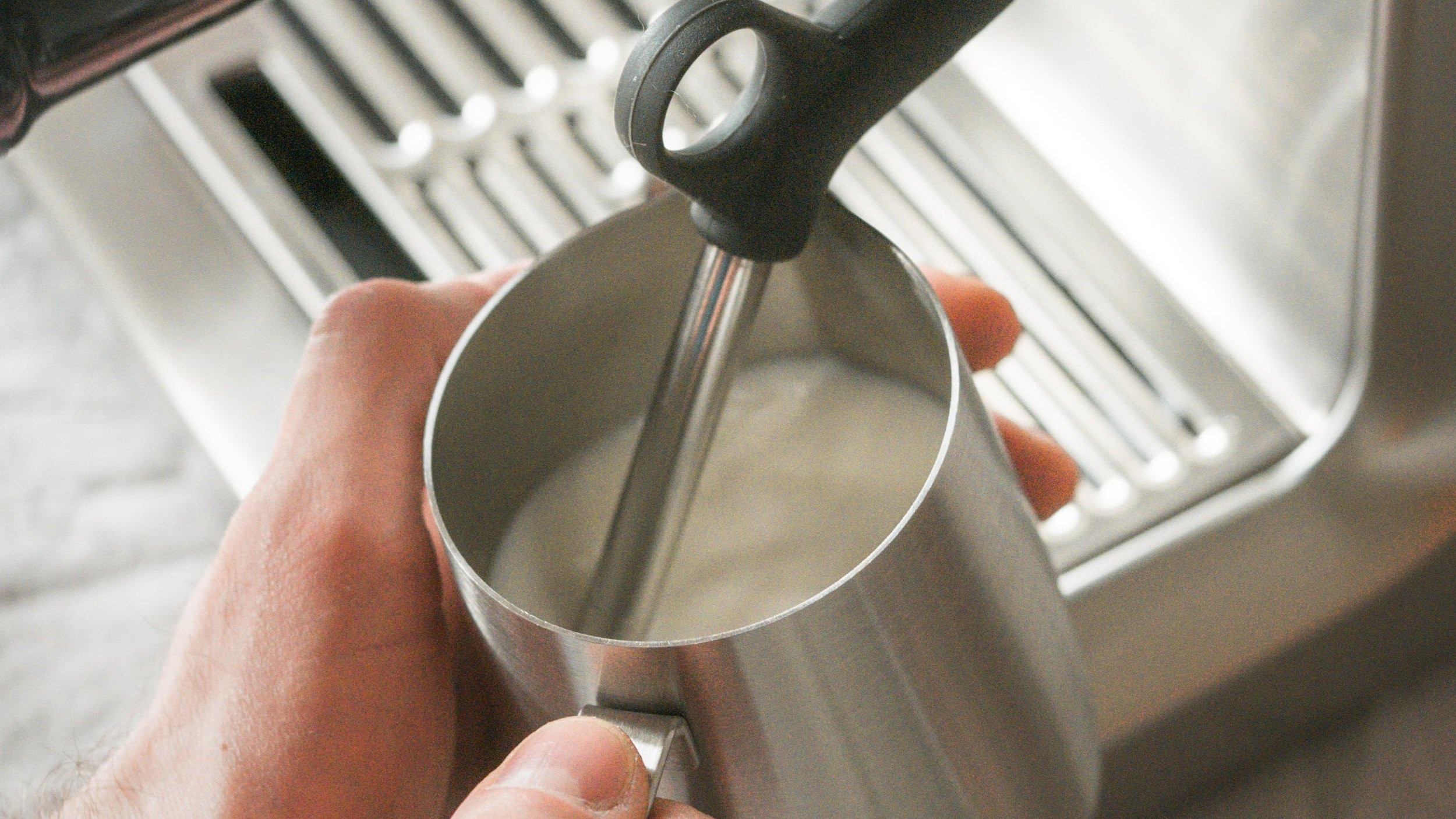Steaming milk at home may seem like a daunting task, but with a few key techniques, it becomes a satisfying and enjoyable part of making your favorite coffee drinks. Whether you're after a creamy latte, a frothy cappuccino, or a strong macchiato, mastering milk steaming is essential. The Breville Barista Express is an excellent tool for achieving professional-grade steamed milk in the comfort of your kitchen. This step-by-step guide will help you get started and perfect your milk-steaming skills. Discover the advanced features and performance of this machine in our Breville Dual Boiler BES920XL review
Why Steamed Milk is Essential for Great Coffee
Steamed milk does more than just create foam; it elevates your coffee experience. The process of steaming milk introduces microfoam—tiny bubbles that create a smooth, velvety texture. This not only enhances the flavor and texture but also balances the rich, bold espresso, resulting in a luxurious, creamy drink. Learn about the ease of use and innovation in our Breville Barista Touch Impress review
When you steam milk properly, it also improves the mouthfeel of the coffee. Steamed milk binds with the espresso in a way that creates a creamy, sweet balance. The flavor becomes richer, the texture more velvety, and the overall experience more indulgent. This is why understanding the art of steaming milk is crucial for crafting high-quality espresso drinks at home. Compare these two popular models in our Breville Barista Express Impress vs Pro review
Getting Your Breville Barista Express Ready for Steaming
The Breville Barista Express (also known as the Sage Barista Express in the UK) is a favorite among home baristas due to its versatility and ease of use. With its efficient steam wand, the Breville makes it simple to achieve café-quality results at home with just a little practice. Find out which machine suits you better in our Breville Barista Pro vs Express review
Before you begin, ensure that your Breville Barista Express is set up correctly. The espresso machine should be on, and the espresso portafilter should be locked into place. If you haven't already made your espresso, do that first before moving on to the milk-steaming portion. Explore the key differences between these premium machines in our Breville Oracle vs Oracle Touch review
Tools Needed for Steaming Milk
Before you start, ensure you have the following essentials ready:
- Breville Barista Express with steam wand: This machine is designed to deliver quality steam, which is key to achieving perfect microfoam.
- Cold milk: Whole milk is often preferred for its creaminess and ability to produce rich microfoam. However, if you prefer plant-based options, choose barista-style oat or almond milk, as these froth better than regular varieties.
- Stainless steel milk jug: This is a must-have for controlling the temperature and ensuring even frothing.
- Optional thermometer: While not necessary, a thermometer can help you avoid overheating the milk. Aim for around 150°F (65°C) for the perfect steamed milk.

Step 1: Prepare Your Machine
The first step to steaming milk successfully on the Breville Barista Express is ensuring that the machine is fully heated. Wait for the steam function light to indicate that it’s ready. However, for the best results, I recommend letting the machine sit for an extra minute after the steam light turns on to allow the steam to reach optimal temperature.
Next, purge the steam wand. This step involves turning the steam dial for a few seconds to release any water that may have condensed inside the wand. This ensures that only steam is delivered to the milk, which is essential for creating the perfect microfoam.
Step 2: Prepare Your Milk
The next step involves preparing your milk. For best results, fill your milk jug about one-third full. This is the optimal amount of milk for frothing, allowing for enough room for the foam to expand. Cold milk is preferable because it gives you more time to work with the texture before it overheats.
Whole milk is typically preferred because of its natural sweetness and rich, creamy texture, which creates the best foam. However, if you are using a plant-based alternative like oat or almond milk, ensure that you use a barista-style version. These have been specially formulated to froth better than regular plant-based milks.
Step 3: Positioning the Steam Wand
Proper positioning of the steam wand is crucial for achieving the right texture. Start by placing the steam wand just below the surface of the milk. Aim for an angle of approximately 15 to 20 degrees. This angle helps create a whirlpool effect in the milk, which breaks larger bubbles into smaller, finer microfoam.
You should also tilt the jug slightly. Position the wand close to the edge of the jug, as this ensures a consistent vortex, which helps create even heating and foam integration throughout the milk. Maintaining a steady vortex is the key to achieving a smooth and glossy texture.
Step 4: Steaming Your Milk
Now it’s time to start steaming your milk. Turn the steam knob on and listen carefully for a soft hissing noise. This is the sound of air being introduced into the milk during the "stretching" phase. For the first 5-10 seconds, keep the wand tip just beneath the surface of the milk. This is where you incorporate air into the milk, creating bubbles that will later form the microfoam.
After the initial stretching phase, lower the jug to fully submerge the steam wand. This begins the "texturing" phase, where the milk heats up and the foam begins to integrate. At this point, the milk should start swirling smoothly, and you’ll notice the foam becoming creamier and more uniform.
The entire process should take about 20 to 30 seconds. If you're using a thermometer, aim for a temperature of around 150°F (65°C). Alternatively, if you're gauging by touch, stop steaming when the jug feels too hot to hold comfortably. You don’t want to overheat the milk, as it can scorch and lose its sweetness.
Step 5: Clean the Steam Wand and Perfect the Texture
Once you have achieved the desired texture and temperature, turn off the steam. The next important step is to clean the steam wand immediately. Use a damp cloth to wipe the wand clean. Then, purge it again to remove any remaining milk that may be left inside the wand.
Now, it’s time to perfect the texture of your milk. Tap the milk jug gently on the counter to break up any large bubbles. Then, swirl the milk gently in the jug to integrate the foam and create a smooth, glossy finish. This shiny appearance is your signal that you’ve achieved the perfect microfoam.
Step 6: Pouring Steamed Milk into Your Coffee
The way you pour your steamed milk is just as important as how you steam it. Pouring the milk correctly creates a balanced coffee drink and allows for beautiful latte art. Begin with a slow, controlled pour, keeping the jug close to the surface of the espresso. This helps mix the milk and espresso evenly.
As you get closer to filling the cup, raise the jug slightly and pour more quickly. This will create the final layer of foam on top. If you’re feeling adventurous, you can experiment with latte art. With practice, you’ll be able to pour beautiful designs such as hearts, rosettas, or even tulips.

Common Issues and Solutions
Steaming milk is a skill that improves with practice, but here are a few common problems and their solutions:
- Milk Not Frothing Well: This is often due to using the wrong type of milk. Ensure that you are using cold, whole milk or barista-grade plant-based alternatives. Additionally, make sure the steam wand is positioned correctly just below the surface of the milk.
- Large Bubbles in the Foam: Large bubbles in the foam can occur if the milk is aerated too much. Avoid over-aerating by keeping the wand just beneath the surface and allowing the milk to swirl smoothly.
- Overheated Milk: If the milk is too hot, it can taste burnt. Use a thermometer to track the temperature or stop steaming when the jug feels too hot to touch.
Conclusion
Learning how to steam milk on the Breville Barista Express is a rewarding skill that takes time and practice. By focusing on proper air incorporation, careful temperature control, and a steady pour, you’ll be able to create luxurious microfoam for café-quality drinks at home. It’s a process that requires patience and attention to detail, but once you get the hang of it, you’ll be crafting professional-grade lattes, cappuccinos, and more in no time. Happy steaming!
